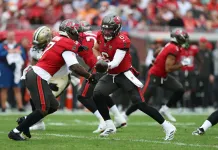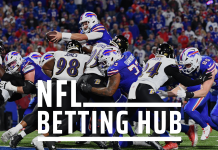NFL Prop Betting Tips for 2024:
In the NFL wagering market, prop bets are certainly the best path for long-term profit. Lines are typically nowhere near as sharp on sportsbooks for player props as they are for sides and totals.
The drawback of prop betting is that limits are traditionally lower due to the increased liability for books. However, that does not prevent you from building a sizable profit, especially with higher volume.
So what are the best ways to attack the NFL prop market? I am Matt Williams, and here are a few tips to give you an edge for the 2024 NFL season.
Line Shopping
My first tip is a classic back-to-basics one: line shopping. I am taking the time to explain this crucial point because it is paramount to long-term success in sports betting.
Often, sports bettors will look at a prop listed at -115 and -120 and think, “Well, they are basically the same.”
No. No they are NOT.
Let me give you an example to show just how vital line shopping can be over a full season:
Let’s say, for argument’s sake, that you are a $100 bettor who placed 100 wagers. Now, let’s also say that you did quite well and won 60% of your bets, going 60-40.
- If you placed all of those bets at -110 (52.38% implied probability), you would have made a profit of $1,454.
- If you made those same exact bets at -130 (56.52% implied probability), you would have made a profit of $615.
- If you made those same exact bets at -150 (60% implied probability), you would have broken even.
Eye-opening? It should be.
Minor odds shifts may not matter much for a single wager, but over time that can have a dramatic impact on your sustainability.
Taking the time to open as many sportsbook accounts as possible to secure the best pricing is a fundamental step to successful sports betting.
Always Do Research
Tip No.2 is also a fundamental basic: Never assume and always do the work.
There are often variables you may be unaware of driving the market—injuries, weather, or any other form of valuable information. This can lead to betting lines that are “too good to be true.”
For example, if you notice that a certain running back is listed for Over/Under a threshold in rushing yards that you feel is a slam dunk, be sure to take the time and double-check news reports.
Perhaps the head coach publicly stated there would be a change in the running backs workload. Maybe a teammate is returning from injury, or the running back at hand got banged up in practice.
This may seem obvious to many of you, but it is paramount that you build good habits of being patient and checking for variables that could impact betting lines.
A few minutes of research can save you a ton of money over the long haul.
Reduce Variance
The beauty of prop betting is being given the ability to hone in on a more specific subset of variables that impact your wager.
For example, if you are betting on rushing yards, you can concentrate on the player’s workload, yards before/after contact, offensive line, and run defense.
If you are betting on passing completions, you will focus on quarterback accuracy, wide receiver matchups, and the defensive scheme.
The point is, there are very few variables outside of the scope that will impact your wager. You can, for the most part, build your analysis on data that directly impacts your prop bet. This reduces variance and allows for a more accurate projection.
On the other hand, you should avoid popular prop traps like “Anytime Touchdown.”
Just hear me out. I can feel some of you rolling your eyes at me right now. “But Matt, touchdown props are fun!” Maybe. But winning is more fun. Touchdown props have almost no bankable correlation to reliable statistics and are at the mercy of uncontested variance.
Game script can greatly determine whether a running back or wide receiver is more likely to see the end zone or if they see the end zone at all. You also have to rely on the variant decision-making of an NFL head coach or offensive coordinator, who last time I checked can not be trusted to make predictable decisions on a consistent basis.
Touchdowns are also variant in nature. Long touchdowns are an unpredictable occurrence, while red zone touchdowns are often determined by inches. Long story short, there are far too many variables that are impossible to predict, so making touchdown props is a losing proposition long term.
You should focus on limiting the amount of question marks in your analysis so that you can more confidently project the outcome.
Analyze Specific Matchups
This tip piggybacks on the last one in terms of reducing variance, but I am going to take it one step further.
We now live in a world where statistical data is both widely available and incredibly in-depth. So, there is no excuse for not taking advantage of every bit of relevant information we can get our hands on.
If you are betting on total receptions for a slot receiver, you should go well beyond comparing simple metrics like average receptions per game versus defensive receptions allowed.
You should be looking at how many routes the wide receiver runs per game, the amount of targets they are seeing, and even the average depth of target. Why? Because you can compare those metrics to how the opposing defense sets up in terms of zone versus man, how close they play slot receivers to the line, and how many receptions they allow specifically to slow receivers.
The above is a specific example, but the thought process can be used for any NFL player prop where matchups come into play.
If this all sounds a bit intimidating, there are plenty of resources to farm advanced data such as NFL Next Gen, NFL Savant, Pro Football Reference, and the valuable tools on VSiN’s website.
Recognize Actionable Trends
You always want to be ahead of the market when it comes to sports betting, but you are never going to get there by scraping the surface. It is important to identify actionable trends that can help you find hidden value in betting lines. The easiest way to do this is to pay attention to meaningful shifts in player usage.
Do you notice that a certain player has seen an increase in total snaps in each of the past three weeks? Is there a rookie wide receiver that is always the top target whenever they are on the field? Has a head coach started to rely on one running back in the red zone more often over the past few games?
This data may not be obvious when looking at a box score, but can be invaluable in terms of projecting future results.
Bet the Under
Spoiler Alert: It is more difficult for something to happen than to simply not. Action is required for yards, receptions, and interceptions. There are far fewer paths to victory when betting the Over than sitting back and rooting for nothing to happen.
This concept may seem too simple for some, but I assure you it’s mathematically sound. Bad weather? Helps the Under. Injuries? Helps the Under. Random stat vultures? Helps the Under.
Furthermore, sportsbooks will typically tax the Over more due to its popularity. People love to bet the over. It’s more fun to root for, and the natural default for most sports bettors is to hammer the Over.
However, there are so many paths to victory when betting the Under that your default setting should always be finding reasons for the Over to fail rather than succeed. Unders are boring and somewhat stressful. But if you enjoy winning, they are your secret weapon.
Bet Early and Often
It’s always preferable to have as much information as possible in regard to weather and player injuries.
That said it is inherently advantageous to be aggressive during the early prop market. Sharp bettors will deflate early value almost immediately, giving you a limited window to identify and leverage opening lines.
As mentioned earlier, there is a ton of advanced data available to help bettors expose the prop market. Unfortunately, you are not the only person trying to accomplish this goal. So be sure to jump in and swim around the prop pool early in the week if you want the best opportunity to benefit.






